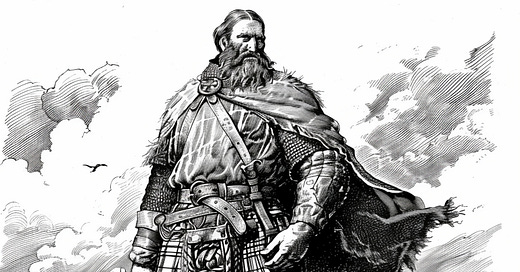The Danish Prince and Clan Cameron
In the heart of Scotland's majestic Highlands, amidst whispers of mist and echoes of ancient battles, the Cameron clan holds dear a legend that intertwines their fate with that of a Danish prince. This narrative, blending the threads of myth and the weft of history, not only enriches the clan's storied past but also embodies the essence of Scottish heritage itself.
The tale begins with a prince from the distant shores of Denmark, whose arrival in Scotland during the reign of King Malcolm III signals the dawn of the Cameron lineage. The prince, whose journey from his homeland speaks volumes of his valor and quest for adventure, is enveloped in mystery. What compelled a royal to leave Denmark and seek a new life in Scotland? The answers vary—ranging from a thirst for glory, escape from turmoil, or the pursuit of autonomy. Each version adds layers to the legend, painting a picture of a man who was as much a pioneer as he was a noble.
A Marriage of Cultures
The integration of the Danish prince into Scottish society was marked by his marriage to a Scottish heiress. This union was more than a mere melding of hearts; it was a strategic alliance that laid the foundational stone for the Cameron clan's rise to prominence. Through this marriage, the prince not only cemented his new Scottish identity but also began a legacy that would echo through the ages. It underscores the importance of alliances and marriages in the medieval period, acting as pivotal events that could alter the course of history.
Beyond the romanticized union, the prince’s martial prowess and leadership qualities are said to have played a significant role in the early days of the clan. The Highland landscape, known for its rugged beauty and harsh conditions, was also a battleground for power and survival. The prince, adapting to his new homeland, is believed to have led his followers with a combination of Danish tactics and Scottish valor, carving out a territory that would become the heartland of Cameron power.
Myths as Cultural Cornerstones
The legend of the Danish prince serves as a vivid reminder of how myths and stories act as cultural cornerstones, binding communities with a shared sense of identity and history. While the historical accuracy of such tales may be debated, their value lies in their ability to convey ideals of bravery, leadership, and resilience. They provide a narrative framework through which clans and communities understand their origins and values, bridging the gap between past and present.
For the modern Cameron clan, the story of their Danish progenitor is not merely a relic of the past but a living heritage that continues to inspire. Clan gatherings, storytelling sessions, and historical research into their lineage are ways in which they keep the legend alive, ensuring that the values and spirit of their ancestors are passed down through generations.
Moreover, the clan's engagement with the broader Scottish diaspora and participation in cultural events highlight the dynamic nature of heritage—it evolves, adapts, and grows while staying rooted in the stories of yore. The Camerons’ embrace of both their mythic and historical past serves as a model for how traditions can be preserved in an ever-changing world.
Conclusion
The saga of the Camerons and their legendary Danish prince encapsulates the essence of Scottish history—a blend of fact and folklore, heroism and heritage. It is a story that resonates not just within the clan but across Scotland and beyond, speaking to the universal themes of identity, legacy, and the enduring power of storytelling. As we delve deeper into the past, stories like these remind us of the complex tapestry of human history, woven from the threads of real events and embroidered with the motifs of myth. In the end, the legend of the Camerons’ Danish prince is more than just a tale from the annals of history; it is a living narrative that continues to shape the identity and pride of a people rooted in the rugged beauty of the Scottish Highlands.





